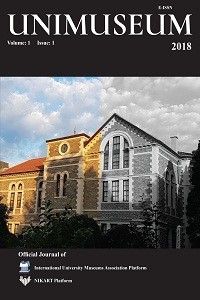Öz
Latvia University Museums serve to increase the value of cultural heritage. Original Greek and Roman works of
art and Latvian art treasures enriched the importance and value of this cultural heritage. Riga Polytechnic Institute
was transformed into Latvia University and collections from this period were gathered together. After unremitting
organizational work, in 1990 a united University of Latvia museum was formed comprising 6 branches: UL Museum
of History, Museum of Zoology, Museum of Geology, Museum of Computing and Informatics, Museum of
Botany and Museum of Pedagogy. After some years new museums were added: Memorial Museum of Friedrich
Zander (Museum of Space Research) and Museum of Human Pathology, and a partnership was formed with the
Latvian Museum of History of Chemistry. Today, the UL Museum of History serves the purposes of education and
science, as well as popularizes the values of cultural history of the University of Latvia.
Anahtar Kelimeler
Kaynakça
- Aronsson, Peter & Elgenius, Gabriella (eds) EuNaMus Report No 1. Published by Linköping University:
- http://www.ep.liu.se/ecp_home/index.en.aspx?issue=064 (accessed 15 January, 2016)
- About the Museum;University of Latvia https://www.lu.lv/eng/general/administrative/museum/mh/about-the-museum (accessed 15 January, 2016)
- Fedorova, Aija.; University oflatvia History Museum, http://www.muzeji.lv/en/museums/university-of-latvia-history-museum/(accessed 15 January, 2016)
- Friedrich Zander’s Memorial Museum tttp://www.latvia. travel/en/sight/university-latvia-friedrich-zanders- muse- um-space-exploration(accessed 15 January, 2016)
- Jocelyn Dodd & Ceri Jones & Andy Sawyer & Maria-Anna .;(2012), Voices from the Museum: Qualitative Research Conducted in Europe’s National Museums, Tseliou EuNaMus Report No: 6, Report series ISSN: 1650-9625, Linköping University Press; p:60-63
- Ķencis, Toms & Kuutma, Kristin.; (2011),National Museums in Latvia, Building National Museums in Europe 1750-2010. Conference Proceedings from EuNaMus, European National Museums: Identity Politics, the Uses of the Past and the European Citizen, Bologna ,28-30 April
- Lotina, Linda.; (2016), Conceptualizing Engagement Modes: Understanding Museum–Audience Relationships in Latvian Museums, University of Tartu Press. ISBN 978-9949-77-049-6,Latvia,P.41-49
- Museum of the University of Latvia; https://www.lu.lv/eng/general/administrative/museum/mpa/(accessed 15 January,2016)
- http://www.lu.lv/par/strukturvienibas-un-infrastruktura/lu-zinatnu-un-tehnikas-vestures-muzejs/lu-vestures-muzejs/(accessed 15 January, 2016)
- http://www.latvia.travel/en/sight/university-latvia-frie-drich-zanders-museum-space-exploration(accessed 15 January, 2016)
Öz
Kaynakça
- Aronsson, Peter & Elgenius, Gabriella (eds) EuNaMus Report No 1. Published by Linköping University:
- http://www.ep.liu.se/ecp_home/index.en.aspx?issue=064 (accessed 15 January, 2016)
- About the Museum;University of Latvia https://www.lu.lv/eng/general/administrative/museum/mh/about-the-museum (accessed 15 January, 2016)
- Fedorova, Aija.; University oflatvia History Museum, http://www.muzeji.lv/en/museums/university-of-latvia-history-museum/(accessed 15 January, 2016)
- Friedrich Zander’s Memorial Museum tttp://www.latvia. travel/en/sight/university-latvia-friedrich-zanders- muse- um-space-exploration(accessed 15 January, 2016)
- Jocelyn Dodd & Ceri Jones & Andy Sawyer & Maria-Anna .;(2012), Voices from the Museum: Qualitative Research Conducted in Europe’s National Museums, Tseliou EuNaMus Report No: 6, Report series ISSN: 1650-9625, Linköping University Press; p:60-63
- Ķencis, Toms & Kuutma, Kristin.; (2011),National Museums in Latvia, Building National Museums in Europe 1750-2010. Conference Proceedings from EuNaMus, European National Museums: Identity Politics, the Uses of the Past and the European Citizen, Bologna ,28-30 April
- Lotina, Linda.; (2016), Conceptualizing Engagement Modes: Understanding Museum–Audience Relationships in Latvian Museums, University of Tartu Press. ISBN 978-9949-77-049-6,Latvia,P.41-49
- Museum of the University of Latvia; https://www.lu.lv/eng/general/administrative/museum/mpa/(accessed 15 January,2016)
- http://www.lu.lv/par/strukturvienibas-un-infrastruktura/lu-zinatnu-un-tehnikas-vestures-muzejs/lu-vestures-muzejs/(accessed 15 January, 2016)
- http://www.latvia.travel/en/sight/university-latvia-frie-drich-zanders-museum-space-exploration(accessed 15 January, 2016)
Ayrıntılar
| Birincil Dil | İngilizce |
|---|---|
| Bölüm | Makaleler |
| Yazarlar | |
| Yayımlanma Tarihi | 1 Temmuz 2018 |
| Gönderilme Tarihi | 1 Aralık 2017 |
| Yayımlandığı Sayı | Yıl 2018 Cilt: 1 Sayı: 1 |
CreativeCommons Attribtion-ShareAlike 4.0 International Licence 146271331027042
Diamond Open Access refers to a scholarly publication model in which journals and platforms do not charge fees to either authors or readers.
Open Access Statement:
This is an open access journal which means that all content is freely available without charge to the user or his/her institution. Users are allowed to read, download, copy, distribute, print, search, or link to the full texts of the articles, or use them for any other lawful purpose, without asking prior permission from the publisher or the author. This is in accordance with the BOAI definition of open access.
Archiving Policy:
http://jfhs.scientificwebjournals.com/en/pub/jfhs/lockss-manifest
Archiving is done according to ULAKBİM "DergiPark" publication policy (LOCKSS).


